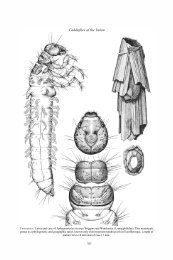No. 9 1998 ARC TIC IN SECT NEWS - Department of Biological ...
No. 9 1998 ARC TIC IN SECT NEWS - Department of Biological ...
No. 9 1998 ARC TIC IN SECT NEWS - Department of Biological ...
Create successful ePaper yourself
Turn your PDF publications into a flip-book with our unique Google optimized e-Paper software.
12 <strong>ARC</strong><strong>TIC</strong> <strong>IN</strong><strong>SECT</strong> <strong>NEWS</strong> <strong>No</strong>. 9, <strong>1998</strong><br />
FEATURE SPECIES: THE <strong>ARC</strong><strong>TIC</strong> WEEVIL ISOCHNUS <strong>ARC</strong><strong>TIC</strong>US<br />
AND ITS CHALCIDOID PARASITOID<br />
Fenja Brodo<br />
Research Associate, Canadian Museum <strong>of</strong> Nature, P.O. Box 3443, Station “D”, Ottawa, Ontario, Canada K1P 6P4<br />
Isochnus arcticus (Korotyaev) (Coleoptera: Curculionidae)<br />
and Pnigalio sp. (Hymenoptera: Eulophidae)<br />
Range: Known from a scat ter ing <strong>of</strong> lo cal i ties in Canada<br />
(Ellesmere Is land, Axel Heiberg Is land, Boothia<br />
Penninsula, Mel ville Is land); in USA: Alaska (Cape<br />
Thomp son, Quoinhagak, St. Paul Is land, St. Mat thew<br />
Is land); and in Rus sia (Wrangel Is land). The fos sil re cord<br />
in di cates that this spe cies has had es sen tially the same<br />
dis tri bu tion since at least the Pleis to cene. The range <strong>of</strong><br />
Pnigalio sp. pre sum ably tracks that <strong>of</strong> I. arcticus. <strong>No</strong>thing<br />
is known <strong>of</strong> its fos sil record.<br />
Male <strong>of</strong> Pnigalio sp.<br />
Hab i tat and lar val food: The wee vil lar vae mine leaves <strong>of</strong> the<br />
pros trate Arc tic Wil low (Salix arctica) growing on<br />
warmer, well-exposed sites. Pnigalio sp. is a pri mary,<br />
sol i tary, ex ter nal parasitoid <strong>of</strong> the wee vil.<br />
Fea tures <strong>of</strong> spe cial in ter est: The most north erly wil low is host to<br />
the most northerly wee vil, a leaf miner, which is it self host<br />
to an un des cribed parasitoid.<br />
Isochnus arcticus<br />
Isochnus arcticus is a high arc tic spe cies <strong>of</strong><br />
particular interest. Leaf mining is a habit that<br />
has been exploited by com par a tively few wee -<br />
vils. Downes (1964) first dis cov ered this weevil<br />
(as Rhynchaenus sp.; re vised by An der son<br />
1989) at Hazen Camp, Ellesmere Island. He<br />
noted that the larvae make blotch mines in wil -<br />
low leaves, pu pate within the leaf and that<br />
adults emerge in the fall at which time they may<br />
feed but do not mate. Adults overwinter in the<br />
leaf litter and the ovarioles in the fe male remain<br />
undifferentiated until the spring.<br />
At Hot Weather Creek, in early June, 1990,<br />
I first noticed small, circular holes, about 1 mm<br />
in diameter, ap pear ing just as new arc tic willow<br />
leaves were more or less expanded. These holes<br />
presumably had been eaten out by adult wee vils<br />
although I never ac tu ally saw a weevil on a leaf.<br />
A few days later, similar-sized but yellowed ar -<br />
eas appeared on wil low leaves. The epidermis,<br />
top and bottom, were in tact, and in between one<br />
could dis tin guish a whit ish blob, the newly<br />
hatched larva. As the weevil larva fed and con -<br />
tin ued to grow within the confines <strong>of</strong> the leaf, it<br />
ate out an increasingly broader area which be -<br />
came discoloured by this wee vil activity and by<br />
the ac cu mu la tion <strong>of</strong> dark gran ules <strong>of</strong> frass<br />
within the leaf (Brodo in press).<br />
In 1990 weevil damage to Salix arctica was<br />
evident on most plants and both adult bee tles<br />
and the immature stages within the leaves were<br />
eas ily collected. Random checking <strong>of</strong> the de -<br />
velopmental progress <strong>of</strong> the immature weevils,<br />
as the season pro gressed, revealed a surprise.<br />
About half the blotch mines which I opened up<br />
contained not one, but two larvae within. They<br />
were both about the same size and were firmly<br />
attached at their head ends.
















